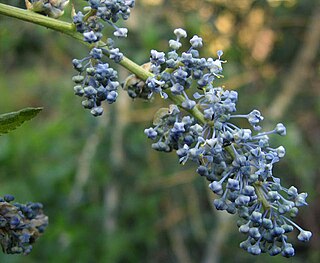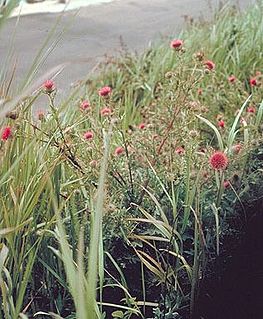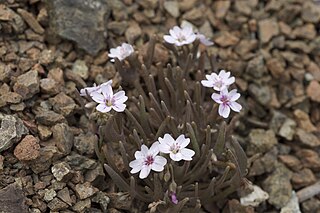
Castilleja arachnoidea is a species of Indian paintbrush known by the common name cobwebby Indian paintbrush.

Symphyotrichum greatae is a species of flowering plant in the family Asteraceae endemic to California and known by the common name Greata's aster.
Calyptridium parryi, synonym Cistanthe parryi, is a species of flowering plant in the family Montiaceae. It is known by the common name Parry's pussypaws. It is native to the southwestern United States and Baja California. It is a small annual herb producing spreading stems up to about 11 centimeters long. There is a basal rosette of small, thick, spoon-shaped leaves no more than about 3 centimeters long, with many along the stems as well. The inflorescence is a cluster a few centimeters wide, with each bearing three white petals surrounded by a few thin sepals. The fruit is a capsule less than a centimeter wide.
Chylismia heterochroma is a species of evening primrose known by the common name Shockley's evening primrose. It is native to the desert slopes and woodland of eastern California and Nevada. It is a hairy, glandular annual herb growing a spindly stem up to a meter tall. There is a thick basal rosette of leaves which are mostly oval in shape and several centimeters in length, and generally no leaves higher up the stem. The inflorescence produces several small flowers with four oval petals just a few millimeters long and lavender in color with yellow-tinted bases. The fruit is a club-shaped capsule roughly a centimeter long.
Tetrapteron palmeri is a species of evening primrose known by the common name Palmer evening primrose. It is native to the western United States from California to Idaho, where it grows in several habitat types, including desert and sagebrush. It is a roughly hairy annual herb growing in a low patch on the ground, generally with no stem. The leaves are widely lance-shaped and up to about 5 centimeters long, with a few small teeth along the edges. The nodding inflorescence produces flowers with yellow petals only 2 or 3 millimeters long each and a noticeable bulbous stigma tip which may be up to a centimeter wide. The fruit is a leathery capsule around half a centimeter long with small wings near the tip.
Camissonia pusilla is a species of evening primrose known by the common name little wiry suncup. It is native to the western United States from California to Idaho, where it grows in sagebrush and other habitat. It is a petite, hairy, glandular annual herb producing very slender erect stems up to about 22 centimeters in maximum height. The leaves linear with toothed edges and 1 to 3 centimeters long. The nodding inflorescence produces flowers with yellow petals 2 or 3 millimeters long and usually spotted with red near the bases. The fruit is a straight or coiling capsule up to 3 centimeters long.
Campanula californica is a species of flowering plant in the bellflower family Campanulaceae, known by the common names swamp bellflower and swamp harebell. It is endemic to California, where it grows along the coastline between Marin and Mendocino Counties. It is found mainly in wet areas such as bogs, marshes, and wet forest floors. This is a hairy rhizomatous perennial herb producing a thin, creeping stem 10 to 30 centimeters long. The thin, rippled leaves are oval in shape and between 1 and 2 centimeters long. The bell-shaped flower is pale blue with curving petals up to 1.5 centimeters long. The fruit is a ribbed, spherical capsule.

Castilleja lemmonii is a species of Indian paintbrush known by the common name Lemmon's Indian paintbrush or meadow paintbrush.
Caulanthus glaucus is a species of flowering plant in the family Brassicaceae known by the common name glaucous wild cabbage.

Ceanothus incanus is a species of shrub in the family Rhamnaceae known by the common name coast whitethorn. It is endemic to California, where it is known from the San Francisco Bay Area through the North Coast Ranges into the Klamath Mountains.

Ceanothus leucodermis, with the common names chaparral whitethorn or chaparral white thorn, is a species of shrub in the family Rhamnaceae. This Ceanothus is an importance browse for several types of ungulate, such as the mule deer and bighorn sheep, who prefer the new growth and shoots to the older, spiny parts.

Ceanothus pinetorum is a species of shrub in the family Rhamnaceae known by the common names Kern ceanothus and Coville ceanothus. It is endemic to the Sierra Nevada of California, where it is known only from the Kern Plateau, a section of the southern Sierra featuring wide meadows and ridges.
Chorizanthe diffusa is a species of flowering plant in the buckwheat family known by the common name diffuse spineflower. It is endemic to California, where it grows on the coastline and mountains of the Central Coast, in sandy scrub, woodland, and forest habitat. It is erect to prostrate in form, its stem generally no longer than 15 or 20 centimeters. The leaves are up to 2 centimeters long and mainly arranged about the base of the plant. The inflorescence is a cluster of flowers, each surrounded by six hook-tipped bracts. The margins of the bracts proximal to the long hooked tip may be very thin and nearly invisible to wide and obvious, and they may be green to white to purplish. The flower itself is about 3 millimeters wide and white with a yellow throat. The tips of its tepals may be smooth or jagged or toothed.

Cirsium andrewsii is an uncommon species of thistle known by the common name Franciscan thistle. It is endemic to California, where it is known from the coastline of the San Francisco Bay Area from Marin to San Mateo Counties. There are also reports of isolated populations in the Klamath Mountains and in the Sierra Nevada.
Cirsium ciliolatum is a species of thistle known by the common name Ashland thistle. It is endemic to the Klamath Mountains, where it is known from only a few occurrences in Jackson and Josephine Counties in Oregon, as well as neighboring Humboldt and Siskiyou Counties in California. It is related to Cirsium undulatum and may be more accurately described as a variety of that species.

Cirsium mohavense is a species of thistle known by the common names virgin thistle and Mojave thistle. It is native to the southwestern United States, where it grows in moist areas in otherwise dry habitat, such as desert springs. It is most common in the Mojave Desert, found also in the southern Great Basin and other nearby regions of California, Nevada, western Arizona, and southwestern Utah.

Clarkia mildrediae is an uncommon species of flowering plant in the evening primrose family known by the common name Mildred's clarkia. It is endemic to California, where it is known from the forests of the southernmost Cascade Range and northern Sierra Nevada. It is an erect annual herb often exceeding half a meter in height. The oval leaves grow up to 6 centimeters long and are borne on petioles of up to 4 centimeters. The inflorescence bears opening flowers and hanging, pointed flower buds. As the bud opens the sepals all separate instead of remaining fused as those of many other Clarkia species do. The triangular to semicircular petals are about 2 centimeters long and lavender to bright reddish-purple, sometimes with dark speckling. There are 8 stamens with anthers all alike, and a protruding stigma.
Clarkia prostrata is a species of flowering plant in the evening primrose family known by the common name prostrate clarkia. It is endemic to the coastline of San Luis Obispo County, California, where it grows on seaside bluffs in forested and grassy areas. This annual herb is prostrate as opposed to erect as most other Clarkia species are. Its stems extend to a maximum length approaching half a meter and are usually somewhat fuzzy in texture. The leaves are oval in shape, up to 2.5 centimeters long, and lack petioles. The sepals of the flower separate into two pairs, revealing the lavender-pink blooming petals. Each petal is just over a centimeter long, fan-shaped to oval, and sometimes with a yellow base marked with a red spot.

Clarkia virgata is a species of flowering plant in the evening primrose family known by the common name Sierra clarkia. It is endemic to California, where it is known from the forests and woodlands of the Sierra Nevada.

Claytonia gypsophiloides, known by the common names gypsum springbeauty and Coast Range claytonia, is a species of wildflower in the family Montiaceae.












